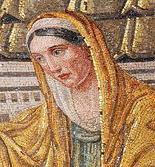Beatified Pre-Congregation Died Rome, Italy Name Pudentiana Pudentiana | Feast 19 May Siblings Praxedes | |
 | ||
Venerated in Roman Catholic ChurchEastern Orthodox Church Attributes Oil Lamp, Laurel Wreath (for Christ) Controversy Martyrdom for refusing to worship the Roman Emperor Similar People | ||
Santa Pudentiana and Santa Prassede, Rome
Pudentiana is a traditional Christian saint and martyress of the 2nd century who became controversial for refusing to worship the Roman Emperors Marcus Aurelius and Antoninus Pius as deities. She is sometimes locally known as Potentiana and is often coupled with her sister, Praxedes the martyr.
Contents
Legend
According to her acta, published by the Bollandists (dating from the 8th century) and the Martyrology of Reichenau, she was a Roman virgin of the early Christian church, daughter of Saint Pudens, friend of the Apostles, and sister of Praxedes. Praxedes and Pudentiana, together with presbyter Pastor and Pope Pius I, built a baptistry in the church inside their father's house, and started to baptize pagans. Pudentiana died at the age of 16, possibly a martyr, and is buried next to her father Pudens, in the Priscilla catacombs on the via Salaria.
While there is evidence for the life of Pudens, there is no direct evidence for either Pudentiana or Praxedes. It is possible that the early Church's "ecclesia Pudentiana" (i.e., the Church of Pudens) was mistaken for "Saint Pudentiana".
Veneration
A basilica in Rome is called Santa Pudenziana and Pudentiana had a commemoration in the General Roman Calendar on 19 May until its 1969 revision. Pudentiana is now mentioned neither there nor in the Roman Martyrology.
The Spanish Conquistador Miguel López de Legazpi, the founder of the city of Manila, gained possession of the territory in 1571 on 19 May, the feast of Pudentiana (in Spanish "Potenciana"), and declared her patron saint of what is now the Philippines.
By the Apostolic Letter Impositi Nobis of 12 September 1942, Pope Pius XII, at the request of the bishops in the Philippines, declared the Virgin Mary under the title of the Immaculate Conception as principal patroness of the Philippines with Saints Pudentiana and Rose of Lima as secondary patronesses, mentioning that historical documents indicated Saint Pudentiana as Patroness of the Philippines from the 16th century and Saint Rose of Lima from the 17th.
Homonymous town in Numidia
The name Pudentiana is also the name of an unrelated ancient town and episcopal see in the Roman province of Numidia, which is among the titular sees listed in the Annuario Pontificio. Two holders of the titular see have become cardinals: Mario Casariego y Acevedo and Oscar Andrés Rodríguez Maradiaga.
